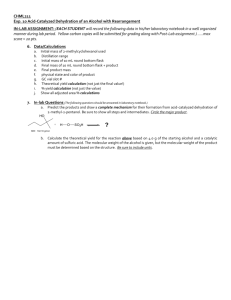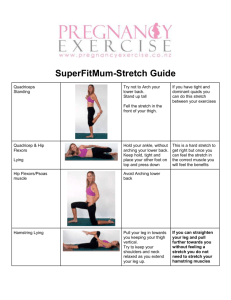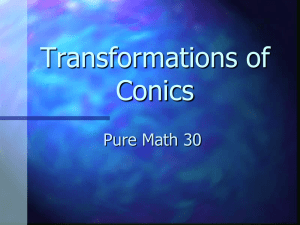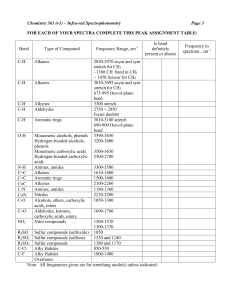Suggestions for IR t..
advertisement
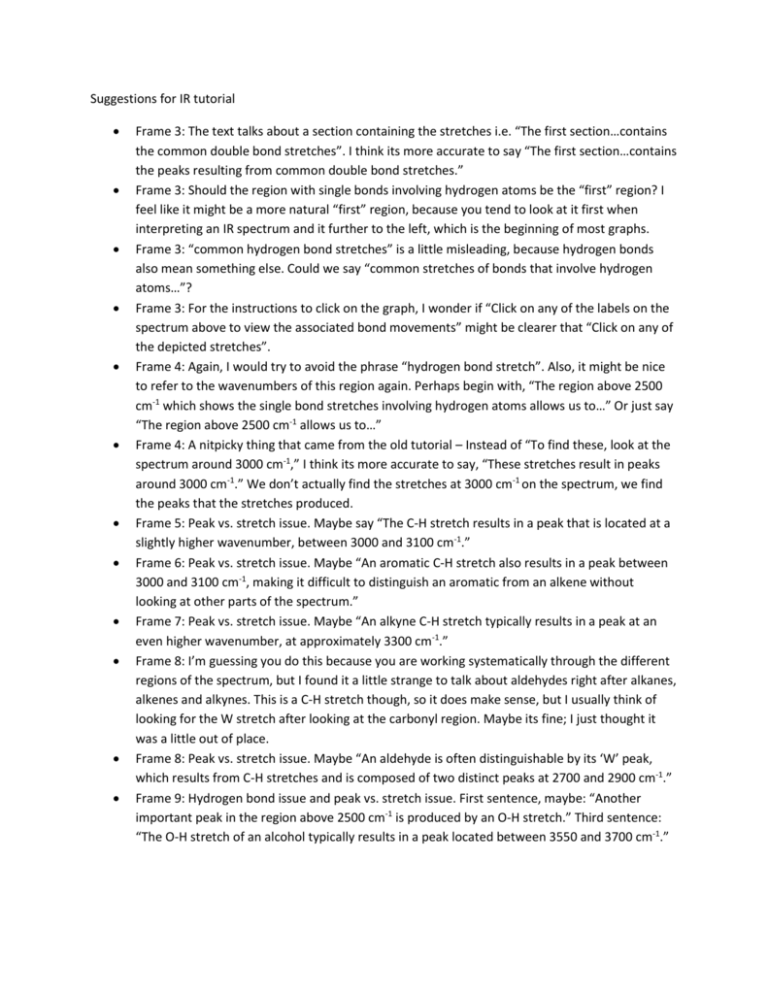
Suggestions for IR tutorial Frame 3: The text talks about a section containing the stretches i.e. “The first section…contains the common double bond stretches”. I think its more accurate to say “The first section…contains the peaks resulting from common double bond stretches.” Frame 3: Should the region with single bonds involving hydrogen atoms be the “first” region? I feel like it might be a more natural “first” region, because you tend to look at it first when interpreting an IR spectrum and it further to the left, which is the beginning of most graphs. Frame 3: “common hydrogen bond stretches” is a little misleading, because hydrogen bonds also mean something else. Could we say “common stretches of bonds that involve hydrogen atoms…”? Frame 3: For the instructions to click on the graph, I wonder if “Click on any of the labels on the spectrum above to view the associated bond movements” might be clearer that “Click on any of the depicted stretches”. Frame 4: Again, I would try to avoid the phrase “hydrogen bond stretch”. Also, it might be nice to refer to the wavenumbers of this region again. Perhaps begin with, “The region above 2500 cm-1 which shows the single bond stretches involving hydrogen atoms allows us to…” Or just say “The region above 2500 cm-1 allows us to…” Frame 4: A nitpicky thing that came from the old tutorial – Instead of “To find these, look at the spectrum around 3000 cm-1,” I think its more accurate to say, “These stretches result in peaks around 3000 cm-1.” We don’t actually find the stretches at 3000 cm-1 on the spectrum, we find the peaks that the stretches produced. Frame 5: Peak vs. stretch issue. Maybe say “The C-H stretch results in a peak that is located at a slightly higher wavenumber, between 3000 and 3100 cm-1.” Frame 6: Peak vs. stretch issue. Maybe “An aromatic C-H stretch also results in a peak between 3000 and 3100 cm-1, making it difficult to distinguish an aromatic from an alkene without looking at other parts of the spectrum.” Frame 7: Peak vs. stretch issue. Maybe “An alkyne C-H stretch typically results in a peak at an even higher wavenumber, at approximately 3300 cm-1.” Frame 8: I’m guessing you do this because you are working systematically through the different regions of the spectrum, but I found it a little strange to talk about aldehydes right after alkanes, alkenes and alkynes. This is a C-H stretch though, so it does make sense, but I usually think of looking for the W stretch after looking at the carbonyl region. Maybe its fine; I just thought it was a little out of place. Frame 8: Peak vs. stretch issue. Maybe “An aldehyde is often distinguishable by its ‘W’ peak, which results from C-H stretches and is composed of two distinct peaks at 2700 and 2900 cm-1.” Frame 9: Hydrogen bond issue and peak vs. stretch issue. First sentence, maybe: “Another important peak in the region above 2500 cm-1 is produced by an O-H stretch.” Third sentence: “The O-H stretch of an alcohol typically results in a peak located between 3550 and 3700 cm-1.” Frame 10: Peak vs. stretch issue. Maybe “A carboxylic acid, on the other hand, will have a very broad peak covering the area between 2400 and 3300 cm-1, resulting from an O-H stretch. The peak may be broad enough to encompass C-H stretches.” Frame 11: Peak vs. stretch issue. Maybe “Similar to the O-H stretch, the N-H stretch of an amine group results in a peak between 3300 and 3500 cm-1.” Frame 12: Peak vs. stretch issue. First sentence, maybe: “The region which contains peaks produced by triple bond stretches contains two important peaks, produced by the alkyne C≡C stretch and the C≡N stretch.” Second sentence, maybe: “The alkyne C≡C stretch results in a peak between 2100 and 2260 cm-1.” Frame 13: Peak vs. stretch issue. Maybe “The nitrile C≡N stretch results in a peak between 2210 and 2260 cm-1.” Frame 14: Second sentence: “This stretch typically results in a very intense peak…” Last sentence, “…a ketone, with a C-H stretch that produces a peak between 1705 and 1725 cm-1.” Frame 15: Peak vs. stretch issue. Maybe “The aldehyde C=O stretch results in a peak between 1720 and 1740 cm-1.” Frame 16: Peak vs. stretch issue. Maybe “The carboxylic acid C=O stretch results in a peak between 1700 and 1725 cm-1.” Frame 17: Peak vs. stretch issue. First sentence, maybe “The double bond stretch region also contains peaks produced by C=C stretches.” Second sentence, maybe “The alkene C=C stretch results in a peak between 1640 and 1670 cm-1.” Frame 18: Peak vs. stretch issue. “The aromatic C=C stretch results in a peak…” Frame 19: I don’t think the overtones of an aromatic are actual stretches, so the first sentence in the second paragraph is a bit misleading, I think. What if it said, “The IR spectrum of an aromatic compound has two unique features that distinguish it from an alkene.” Also, it might be nice to highlight that the overtone region consists of very small peaks; maybe “Aromatic compounds also have an overtone region, consisting of very small peaks between 1600 and 2000 cm-1.” Frame 20: Peak vs. stretch issue. “bend produces a peak between…” Frame 21: Peak vs. stretch issue. “stretch results in a peak between…” Frame 22: Peak vs. stretch issue. “stretch that results in a peak between…” Frame 23: Second sentence; rather than “look at the region…for C-H stretches”, maybe “look at the region…for peaks resulting from C-H stretches.” Frame 24: A typo. There is a period after “For example”. Also, I’m not sure that it is clear what the “it” in the last sentence is referring to. It might be more clear to say “look for the characteristic ‘W’ C-H stretch to see if the compound is an aldehyde.” Frame 24 and 25: On frame 23, it says to look at the spectrum in three steps, which I like. I think on the next two frames, it might be useful to refer back to the “steps.” i.e. to say on frame 24, “The second step is to look at the area between…” or on frame 25, “The final step is to look at the region above…” Frame 25: “which further simplifies the spectrum” sounds a little vague to me. What if we said, “which helps to determine the compound’s identity”?
